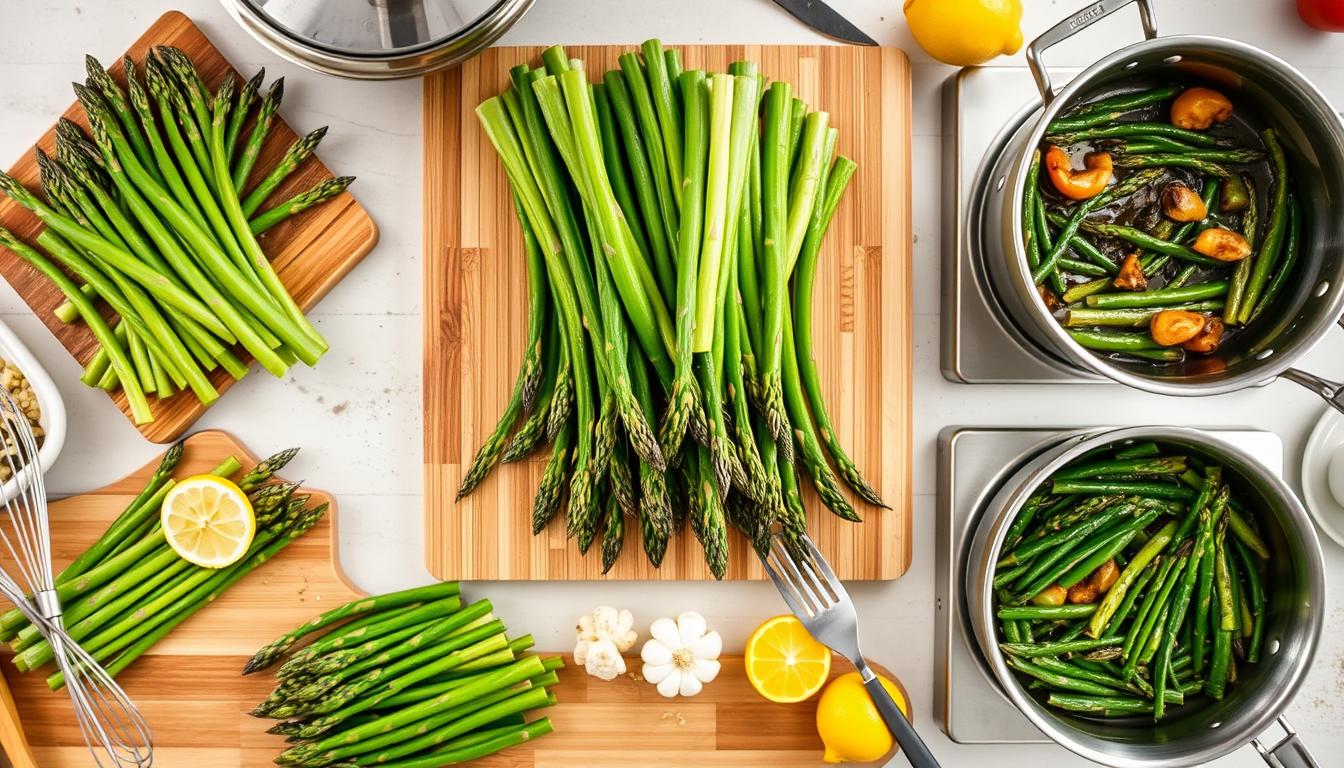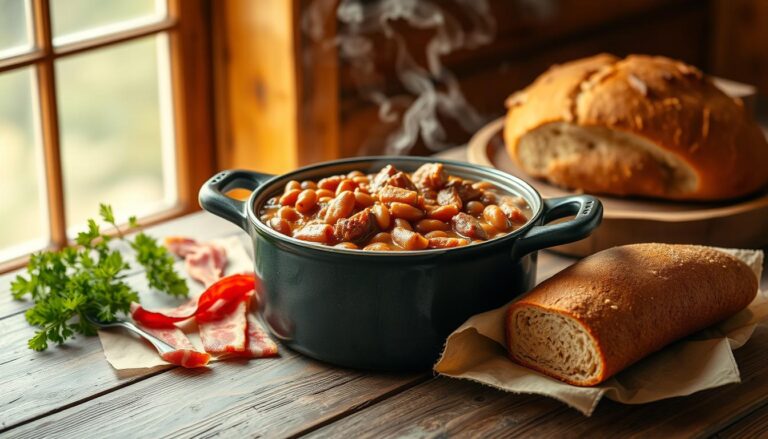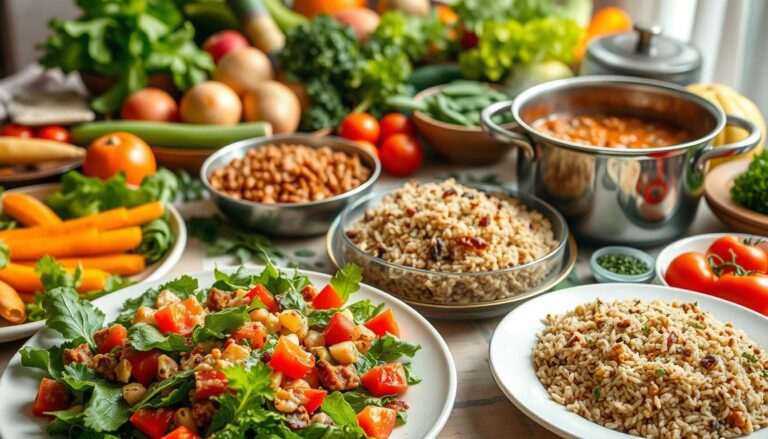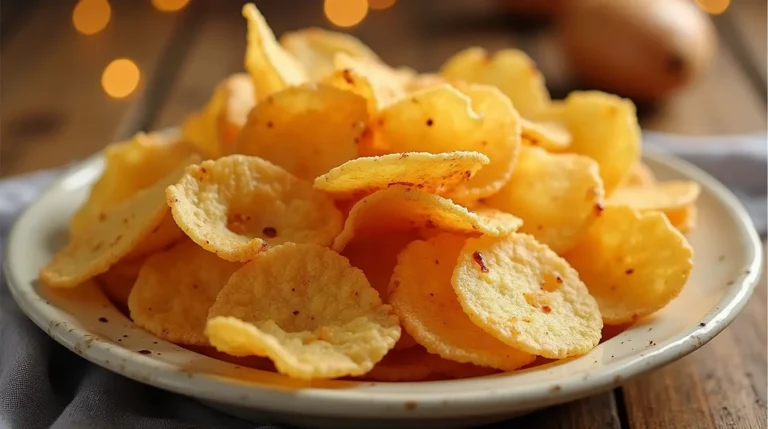How to Make Asparagus: Simple Asparagus Recipe
Asparagus is a tasty and flexible vegetable. It can be cooked in many ways. With lots of asparagus recipes out there, starting to cook asparagus is easy. Whether you’re new to cooking or have experience, learning to cook asparagus can make your meals better and healthier.
Table of Contents

Cooking asparagus is fun and rewarding. You can try different recipes and techniques. From simple steaming to complex roasting, there’s a method for everyone. By following a simple recipe and using the right tools and ingredients, you can make delicious, healthy meals that highlight asparagus’s unique flavor and texture.
Key Takeaways
- Asparagus is a versatile vegetable that can be prepared using various asparagus cooking methods
- There are numerous asparagus recipes available to suit different tastes and dietary preferences
- Mastering the art of asparagus preparation can elevate your meals and provide essential nutrients
- Simple asparagus recipes can be a great starting point for beginners
- Exploring different asparagus cooking methods and techniques can help you create delicious and healthy meals
- Using the right tools and ingredients is crucial for preparing perfect asparagus dishes
Understanding Asparagus: A Versatile Spring Vegetable
Asparagus is a favorite spring veggie packed with asparagus nutrition benefits. It’s great for a healthy diet. Its unique taste and texture make it perfect for many dishes.
There are green, white, and purple types of asparagus. Each has its own taste and look. Asparagus is in season from February to June, peaking in March to May.
Asparagus is full of vitamins A, C, and K, and is low in calories. Knowing about the types of asparagus helps you pick and prepare it wisely.
Different Types of Asparagus
- Green asparagus: This is the most common type. It tastes slightly sweet and tender.
- White asparagus: Grown underground, it’s milder than green asparagus.
- Purple asparagus: It has a richer flavor than green asparagus. It’s often used in special dishes.
Seasonal Availability
Asparagus is available from February to June. The best time is March to May. This is when it’s freshest and tastiest.
Nutritional Benefits
Asparagus is full of nutrients. It’s low in calories but rich in vitamins A, C, and K. It’s a great choice for a healthy diet.
Selecting the Perfect Asparagus Spears
Choosing the right asparagus is key to a great dish. Look for spears that are firm, straight, and bright green. Stay away from wilted, bent, or brown-tipped spears, as they might be old or damaged.
Think about the thickness of the spears too. Thicker spears are great for grilling or roasting. They can handle high heat well. Thinner spears are better for sautéing or steaming because they cook fast and evenly.
- Choose spears with tightly closed buds, as these will be more tender and flavorful.
- Avoid spears with open or flowering buds, as these can be bitter and tough.
- Consider the season and choose spears that are in season, as these will be fresher and more flavorful.
By following these tips, you can pick the best asparagus spears for your dish. Whether you’re grilling, roasting, or sautéing, the right spears will make a big difference.
Essential Tools and Ingredients for How to Make Asparagus Recipe
To make a tasty asparagus dish, you need the right tools and ingredients. A well-stocked kitchen is key to a great final product.
Start by getting the basic kitchen equipment. You’ll need a pot, steamer basket, and cutting board. These help clean, trim, and cook the asparagus. Sharp knives and a colander are also useful for prep.
Kitchen Equipment Needed
- Pot
- Steamer basket
- Cutting board
- Sharp knives
- Colander
For asparagus ingredients, start with olive oil, salt, and pepper. These basics enhance the asparagus’s natural taste. You can also add garlic, lemon juice, and parmesan for extra flavor.
Basic Ingredients List
- Olive oil
- Salt
- Pepper
With the right tools and ingredients, you’re ready to make a delicious asparagus dish.
Properly Cleaning and Trimming Asparagus
Cleaning asparagus is key before cooking. Start by rinsing it under cold water to get rid of dirt. Then, dry it with a paper towel to remove extra moisture.
Next, trim the asparagus to get rid of tough parts. Cut off the bottom inch of each spear. You can also peel it to remove tough skin. Here’s how to clean and trim asparagus right:
- Rinse the asparagus under cold running water
- Pat the asparagus dry with a paper towel
- Trim the ends of the asparagus, removing any tough or woody parts
- Peel the asparagus, if desired, to remove any tough skin
Cleaning and trimming asparagus well can really improve its taste and texture. By following these steps, your asparagus will be clean, tender, and ready to cook.

Be gentle when handling asparagus to avoid breaking it. With the right cleaning and trimming, you can enjoy healthy asparagus dishes all year.
| Step | Description |
|---|---|
| 1 | Rinse the asparagus under cold running water |
| 2 | Pat the asparagus dry with a paper towel |
| 3 | Trim the ends of the asparagus, removing any tough or woody parts |
| 4 | Peel the asparagus, if desired, to remove any tough skin |
Basic Preparation Methods
Cooking asparagus can be easy and tasty. There are many ways to do it, like blanching. This method involves boiling the spears briefly. It keeps them green and crunchy.
Other methods include steaming, roasting, and grilling. Each one needs just a few tools and ingredients. For instance, steaming needs a steamer basket and boiling water. Roasting requires a hot oven and a baking sheet.
Blanching Technique
Blanching asparagus is quick and simple. Just boil the spears for 3-5 minutes. Then, cool them in an ice bath to stop cooking.
Steaming Process
Steaming asparagus is good for keeping nutrients and flavor. Place the spears in a steamer basket over boiling water. Cover and cook for 4-6 minutes.
Roasting Instructions
Roasting asparagus brings out its sweetness. Preheat the oven to 425°F (220°C). Toss the spears with olive oil, salt, and pepper. Cook for 12-15 minutes.
Grilling Guidelines
Grilling asparagus adds a smoky taste. Brush the spears with olive oil. Grill over medium-high heat for 3-5 minutes on each side.
| Method | Equipment | Cooking Time |
|---|---|---|
| Blanching | Pot, boiling water, ice bath | 3-5 minutes |
| Steaming | Steamer basket, pot, boiling water | 4-6 minutes |
| Roasting | Oven, baking sheet, olive oil | 12-15 minutes |
| Grilling | Grill, olive oil | 3-5 minutes per side |
Seasoning Your Asparagus
Seasoning asparagus opens up a world of flavors. You can use salt, pepper, garlic powder, and paprika to enhance its taste. For a zesty twist, squeeze some lemon juice or sprinkle parmesan cheese on top.
Here are some popular seasoning options for asparagus:
- Salt and pepper: a classic combination that enhances the natural flavor
- Garlic powder: adds a savory and aromatic flavor
- Paprika: provides a smoky and slightly sweet flavor
- Lemon juice: adds a bright and tangy flavor
- Parmesan cheese: adds a nutty and savory flavor
Trying different asparagus recipes and seasonings can lead to your favorite way to enjoy asparagus. Whether it’s a simple or complex mix, the goal is to highlight the asparagus’s natural taste.

Exploring various seasoning options and asparagus recipes can introduce new flavors. So, don’t hesitate to be creative and find your ideal seasoning mix.
Common Cooking Mistakes to Avoid
When cooking asparagus, it’s key to know common mistakes. These can ruin your dish. Overcooking asparagus is a big mistake. It makes the asparagus mushy and not tasty.
Some common mistakes to watch out for include:
- Overcooking, which can be avoided by checking the asparagus frequently during the cooking process
- Seasoning errors, such as adding too much salt or not enough seasoning
- Storage mistakes, like storing asparagus at room temperature, which can cause it to spoil quickly
To avoid these mistakes, it’s crucial to understand the basics of asparagus cooking. Following a tried-and-true recipe is key. By being mindful of these common errors, you can ensure that your asparagus dish turns out delicious and enjoyable.
| Mistake | Effect | Prevention |
|---|---|---|
| Overcooking | Mushy asparagus | Check asparagus frequently during cooking |
| Seasoning errors | Unappetizing flavor | Use the right amount of seasoning |
| Storage mistakes | Spoilage | Store asparagus in the refrigerator |
Pairing and Serving Suggestions
Asparagus is a versatile vegetable that pairs well with many main dishes. Try it with grilled chicken, pan-seared salmon, or roasted beef. These options complement asparagus’s earthy flavor, making for a balanced meal.
Consider serving asparagus as a side dish or adding it to salads, pasta, and risottos. It also goes great with creamy sauces like hollandaise or beurre blanc. Here are some favorite ways to enjoy asparagus:
- Grilled chicken with roasted asparagus and quinoa
- Pan-seared salmon with steamed asparagus and brown rice
- Roasted beef with sautéed asparagus and roasted vegetables
Main Dish Combinations
Asparagus pairs well with a variety of main dishes. It’s great with grilled chicken, pan-seared salmon, and roasted beef. These combinations make for a satisfying meal.
Wine Pairing Recommendations
For wine, asparagus goes well with crisp white wines like Sauvignon Blanc and Pinot Grigio. These wines enhance asparagus’s delicate flavor. For something richer, try asparagus with hollandaise or beurre blanc and a glass of Chardonnay or Champagne.
| Wine | Pairing Suggestions |
|---|---|
| Sauvignon Blanc | Grilled chicken, steamed asparagus, and quinoa |
| Pinot Grigio | Pan-seared salmon, roasted asparagus, and brown rice |
| Chardonnay | Roasted beef, sautéed asparagus, and roasted vegetables |
Storage and Leftover Management
Keeping asparagus fresh is key. To store it, wrap it in a paper towel or plastic bag and put it in the fridge. This keeps it moist and fresh for 3-5 days. You can also freeze it, blanched or unblanched, for soups, stews, and casseroles.
Reheating asparagus leftovers safely is important. Heat it to 165°F (74°C) to avoid foodborne illness. Here are some tips for handling asparagus leftovers:
- Store leftovers in a covered container in the fridge for up to 3 days.
- Freeze leftovers for later use in soups, stews, or casseroles.
- Reheat leftovers to 165°F (74°C) for food safety.
By following these tips, you can enjoy asparagus while reducing waste. Proper storage and handling are key to keeping it fresh and safe.
Asparagus is a versatile vegetable that can be stored and reheated safely with proper techniques.
Always check the freshness and safety of your asparagus before eating it. Enjoy this nutritious veggie in many dishes.
| Storage Method | Shelf Life |
|---|---|
| Refrigeration | 3-5 days |
| Freezing | Up to 8 months |
Conclusion: Mastering the Art of Asparagus Preparation
Through this guide, you’ve learned how to master asparagus cooking. Choosing fresh asparagus spears and using the right techniques are key. Seasoning with care brings out the true flavor and texture of this spring veggie.
With practice, you’ll become skilled at making delicious asparagus dishes. These dishes will impress everyone you share them with. You’ll be able to create beautiful and tasty asparagus dishes with ease.
Success in cooking asparagus comes from paying attention to the details. From trimming the ends to choosing the best cooking method, these tips will help you. Follow them to make asparagus dishes that will wow your guests.
Now that you know how to cook asparagus, start exploring its many uses. This nutritious veggie offers endless possibilities for delicious meals. So, use your new skills to create amazing asparagus dishes and enjoy the process.
FAQ
What are the different types of asparagus?
Asparagus comes in three main types: green, white, and purple. Each type has its own unique taste and look.
When is asparagus in season?
Asparagus is in season from February to June. The best time is from March to May.
What are the nutritional benefits of asparagus?
Asparagus is packed with vitamins A, C, and K. It’s also low in calories.
How do I select the perfect asparagus spears?
Choose spears that are firm, straight, and bright green. Avoid wilted, bent, or brown spears.
What kitchen equipment do I need to make asparagus?
You’ll need a pot, steamer basket, and cutting board. Optional tools include a vegetable peeler and sharp knife.
How do I properly clean and trim asparagus?
Rinse under cold water, pat dry, and trim the ends. You can also peel it if you like.
What are the basic preparation methods for asparagus?
Common methods include blanching, steaming, roasting, and grilling.
How can I season my asparagus to enhance the flavor?
Season with spices and herbs like salt, pepper, garlic powder, paprika, lemon juice, or parmesan cheese.
What are some common cooking mistakes to avoid when making asparagus?
Avoid overcooking, bad seasoning, and wrong storage.
What are some good pairing and serving suggestions for asparagus?
Asparagus goes well with grilled chicken or pan-seared salmon. It’s great as a side or in salads, pasta, and risottos. It also pairs well with crisp white wines, like Sauvignon Blanc.
How should I store and manage leftover asparagus?
Store in the fridge, wrapped in a paper towel or plastic bag. Use within 3-5 days. You can also freeze it for longer.







